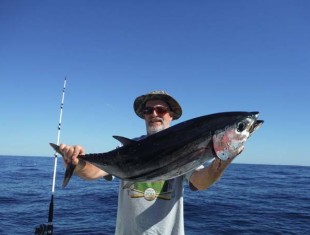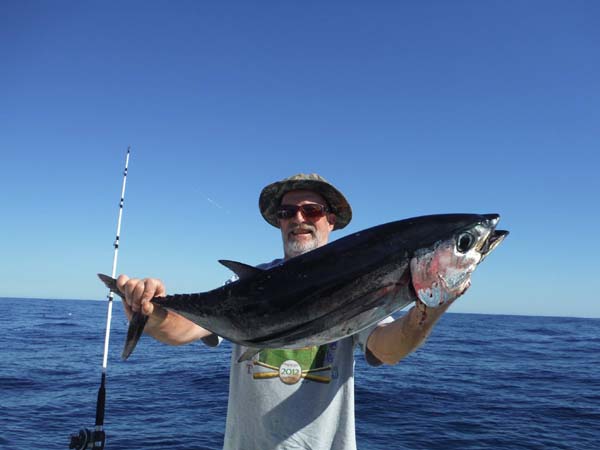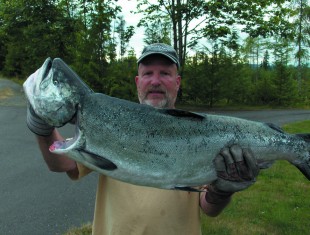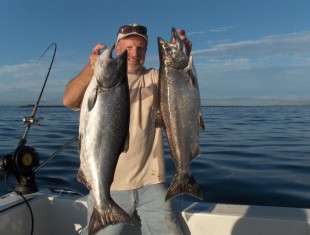EARL SANDE AND LARGE TUNA
Two years ago I found out just how good tuna fishing can be out of Westport during the month of October. That year we went out on October 12th which happened to be opening day of deer season. Tim Zech called me on the 10th and said “The weather looks good for tuna!”
We knew it would be our last chance of the year as we all had hunting plans for the following week. We went southwest out 40 miles and were amazed to see tuna jumping all around us as far as we could see! In two stops while fishing with live bait we caught 56 tuna and were soon headed back to Westport at 30 miles per hour under clear, calm conditions.
This year we planned going sometime during September, but the weather just didn’t want us to go when we wanted to go. Finally, the October 4th forecast looked like fairly calm tuna water.
We had a crew of four that included Tim’s brother Steve and Tim’s son Taylor and me. At 4:15 A.M. we were gassing up Tim’s 24-foot Sea Sport in Belfair and two hours later we were buying live bait at the Westport Marina. We loaded two nets of anchovies into the live tank at 50 bucks each. Ten years ago it was five dollars each, but when you’re the only game in town they can charge whatever people are willing to pay.
The last two days the tuna reports were good for 50 miles west and a bit north. Once we motored off the continental shelf and in 2500 feet of water we saw lots of tuna were jumping and they seemed to be big, like maybe 20-30 pounds.
We all grabbed a pole and hooked up a live anchovy on a tiny tuna hook. A few moments later the crew was yelling fish on!!
It wasn’t long before we had five in the now bloody fish box. But there was one problem. I hadn’t had a bite!
I never have taken the time to buy a pole, reel and line exclusively for tuna fishing with live bait. I’ve been using one of my bottom fishing poles with braided line which has worked fine in the past. But these tuna were different. They were big, older and apparently much wiser. There was little doubt in my mind they could easily see the line and wanted nothing to do with it, even though I had three feet of sea- guar invisible leader on the end.
All of Tim’s poles had the nearly invisible mono line on them, so I quickly traded mine in. Within 30 seconds I had my first tuna of the day on. I tightened the drag, but the line was still screaming off the reel. I knew better, but I put my thumb on the reel and seconds later my skin was fried. A 25- pound tuna is an amazing swimming machine. Pound for pound, no other fish in the sea even comes close as far as I know.
It was a very busy couple of hours as we had three big tuna on at the same time more than once. We were all down to our tee shirts and the sweat was dripping off our foreheads. This was extreme fishing at its finest.
We had all fished together before so we knew what to do, and even though gaffed tuna were flying through the air and blood was just about everywhere it was really just organized chaos.
By the time we ran out of live bait we had 22 tuna between 22 and 30 pounds and should have had at least six more that came off close to the boat. But we were very satisfied with the days catch and iced down the fish boxes. Two hours later we had the boat on the trailer and headed for home.
Albacore tuna (Thunnus Alalunga) are perfectly designed for speed and are among the fasted and highest endurance species in the world’s oceans. These fish are powerful ocean predators and have been clocked swimming at 60 mph. There have been disputed claims of albacore swimming up to 73 mph for a short burst.
These high-performance fish require a lot of fuel and they will spend most of their life looking for food in the open ocean. Tagging studies have shown that albacore can travel more than 5,000 miles in less than one year, from California to Japan.
Tuna feed on anything that swims that they can swallow, including anchovies, sardines, herring, myctophids, suary, small rockfish, squid and euphasiids. Their only known predators that are fast enough to catch them are blue and striped marlin and Wahoo.
Albacore, which are members of the mackerel family and can reach maturity in six years, are found in all the world’s warm oceans but appear to be more abundant in the Pacific. They prefer water between 58 and 70 degrees and are often found in the vicinity of underwater mountains and above banks and valleys on the ocean floor.
The albacore is one of the smaller tuna species with an average weight of around 20 pounds, but can grow much larger. The all-tackle record is 88 pounds taken near the Canary Islands.
Albacore can grow pretty fast and seldom live beyond 12 years. After one year they weigh between two and six pounds and can be 18 inches long. At three years they can by 14 pounds; at four 22 pounds; at five 30 pounds; at six 40 pounds; at seven 46 pounds; at eight 54 pounds; at nine 60 pounds; and at twelve 85 pounds.
North Pacific albacore are considered to a single spawning stock. Most spawning happens from March through August in the subtropical Pacific Ocean somewhere between Mexico and the Philippines.
Female albacore over four years old will spawn from 1,000,000 to 3,000,000 eggs that will float near the surface until they hatch. The juvenile tuna will remain in the area where they were spawned until their second year. That spring they will begin their northern migration up the North American coast.
Albacore tuna swim and feed near the surface together in loose formations for the first five years of their lives. But under stormy conditions they may dive down 500 feet until the sea calms. As they get older they become more independent and spend more of their time in deeper and cooler water, but still may hunt for food near the surface at night.
Albacore never swim in really tight schools. That’s why most commercially caught albacore are not caught by purse seiners. Fishermen must catch them one-by-one with troll, long line, or pole and line gear.




